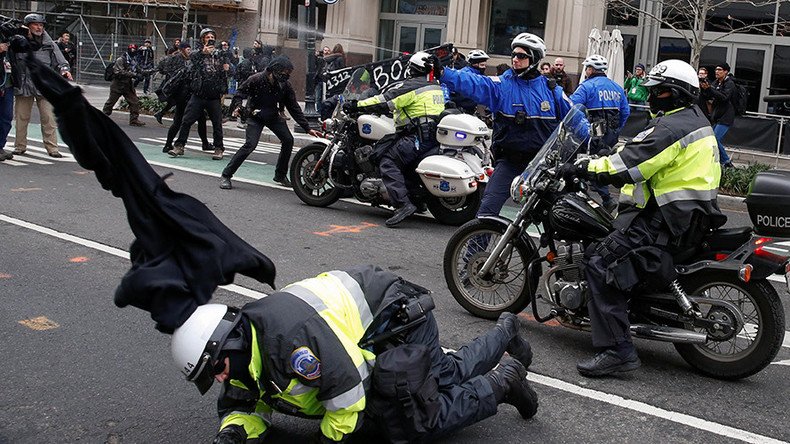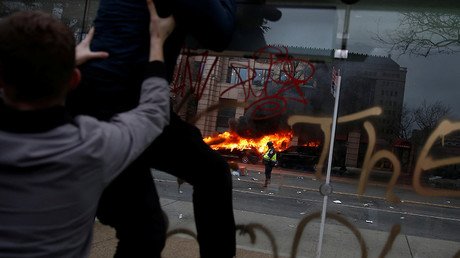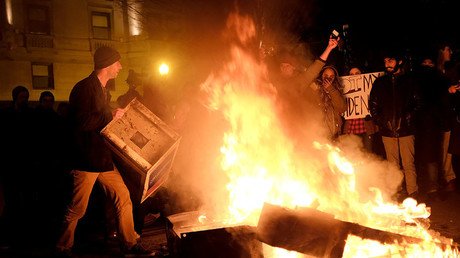DC police watchdog questions arrests of journalists & use of force on Inauguration Day

A review of the Metropolitan Police Department’s actions on Inauguration Day found that officers may not have properly followed procedures when they clashed with protesters in Washington, DC, according to the city’s police oversight board.
The five-member Police Complaints Board (PCB) ‒ made up of one MPD member and four civilians with no current law enforcement affiliations ‒ oversees the Office of Police Complaints, which sent out monitors on January 20 to observe the interactions between city police and the public. On Monday, the board issued its findings about Inauguration Day, when more than 200 people were arrested and charged with felony rioting during clashes with police, and recommended further investigation.
“The Police Complaints Board (PCB) concludes that while in many instances MPD conducted activities in a constitutional manner, there are several instances where the observations made by OPC cause concern and raise questions,” the 17-page report said.
Among those concerns were police who did not follow department procedures for First Amendment gatherings, officers who attacked and arrested members of the media and other observers who were not involved with the riots, and the use of force and less-than-lethal weapons without first warning the crowds.
The report outlined three specific instances that “appear to be anomalies” in which officers were not displaying nameplates and badge numbers, specifically when “two MPD officers in riot gear were not displaying name tags, but their badge numbers were visible, as the newly issued MPD protective helmets have officers’ badge numbers imprinted on the front above the visor.”
At a security checkpoint where protesters were blocking access, a supervisor told other officers to “push her down or out,” referring to a woman with a “long lensed camera” in the area, “expressing the desire to use force on a woman who appeared to be news media, and had not yet been asked to move in any way.”
When demonstrators linked arms to form a wall to block another entrance, MPD officers “appeared to have to use some degree of physical force in order to separate the protesters.” Unidentified protesters told a monitor that one particular officer there “had been striking protesters earlier in the day” and “pulled a protester’s hair to get her to move.”
MORE: police dispersed crowd, who continue #disruptJ20 protests elsewhere in DC ahead of #Inaugurationhttps://t.co/0RBGfBqr4Tpic.twitter.com/2W4fZnCxC4
— RT America (@RT_America) January 20, 2017
Most of the rioting and arrests on Inauguration Day took place in the area around Franklin Square Park. Complaints about this area included officers who pepper-sprayed into the crowd without giving warnings first, an officer pepper-spraying easily-identifiable OPC monitors in the crowd, and the use of “stingers” on a crowd that contained bystanders and news media. One OPC monitor was “struck in both legs in multiple places with the rubber pellets from the stinger.”
In addition to the MPD officers, there were approximately 3,000 officers from federal agencies and other local jurisdictions, but they were not covered in the report. Along with OPC monitors, the board reviewed news media, social media and reports from other observers, including those from the District of Columbia Bar Association, “to obtain additional context of the events.”
The report criticized MPD for arresting and corralling people “even though they claimed to have not taken part in any rioting or acts of vandalism.” The people involved in the rioting “were dressed in all black, yet many who were cordoned off and then arrested wore press identification or green legal observer hats, differentiating them visibly from those engaged in unlawful acts.” One of the journalists who was arrested on January 20 was RT America’s Alexander Rubinstein; felony rioting charges against him have since been dropped.
The fact that many of the people arrested didn’t appear to participate in the rioting could end up hurting the prosecution of those cases because “it would likely be a challenging task to make a probable cause determination for each person arrested... in the Franklin Square Park area,” the report said.
Along with issues regarding how officers interacted with the public, there were also inter-agency problems, the report found. MPD was supposed to take the lead in “any incidents requiring riot gear,” according to pre-event briefings, but US Park Police officers “were also in riot gear, and appeared at times to be acting independently of MPD.”
The board concluded that MPD should hire an independent consultant to “investigate and examine all aspects” of the department’s actions on Inauguration Day, including police footage from body-worn and other cameras.
MPD handled the Women’s March on Washington the following day, January 21, in a very different manner: “OPC’s overall impression is that MPD performed in a professional manner and effectively balanced the interests of public safety with the right to free expression,” the PCB said in a second report issued on Monday. However, the board expressed concern that officers did not spread out far enough along the march route to the north and west of the original rally point.
#WomensMarch: The crowds in Washington DC are swelling, the majority wearing pink 'pussy hats' https://t.co/THHizl3ZbVpic.twitter.com/O5S9fwNjJz
— RT America (@RT_America) January 21, 2017
“Several traffic intersections quickly became dangerous for pedestrians, there was little traffic control, and it was difficult to find any officers at many points along the march route and in the downtown area,” the 10-page report said.
One other complaint that OPC had about the march was that “monitors did observe several uniformed MPD officers wearing pink hats, which was the item worn by march participants to show their support of the event.”















